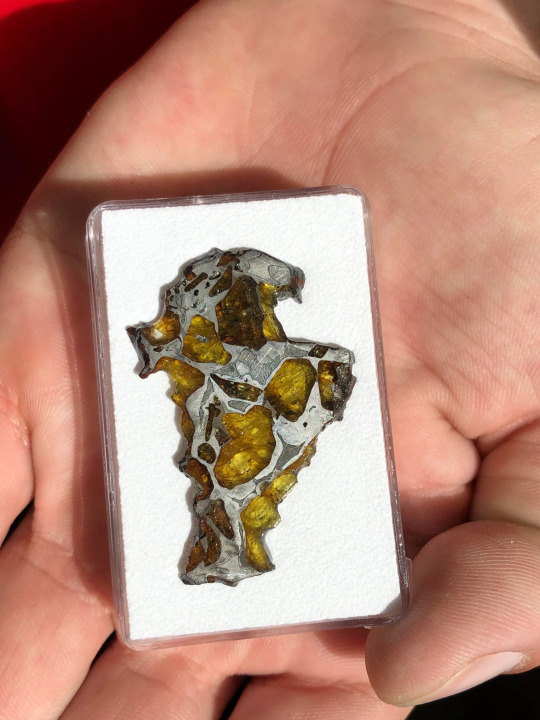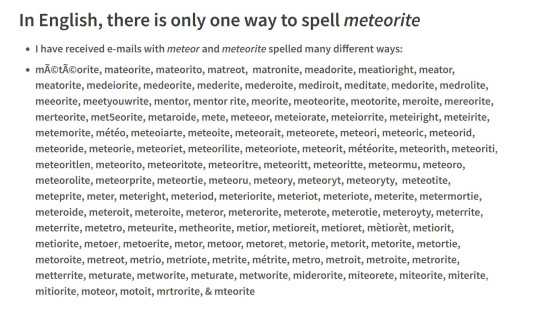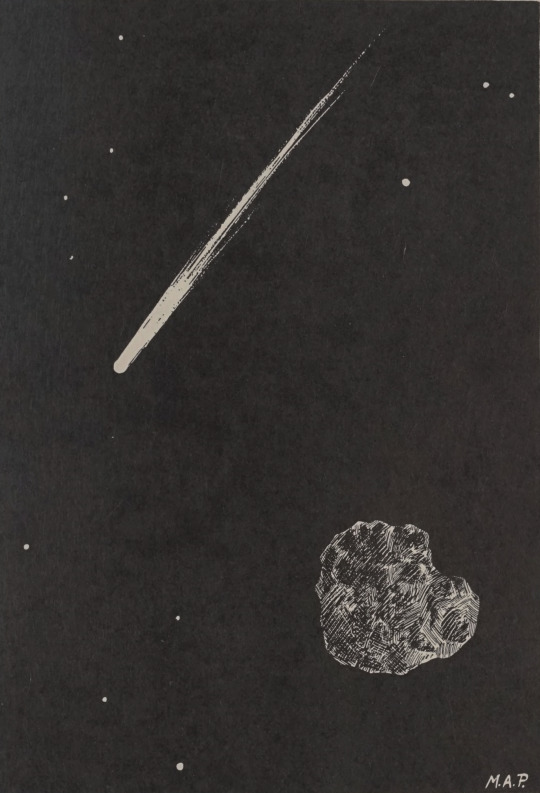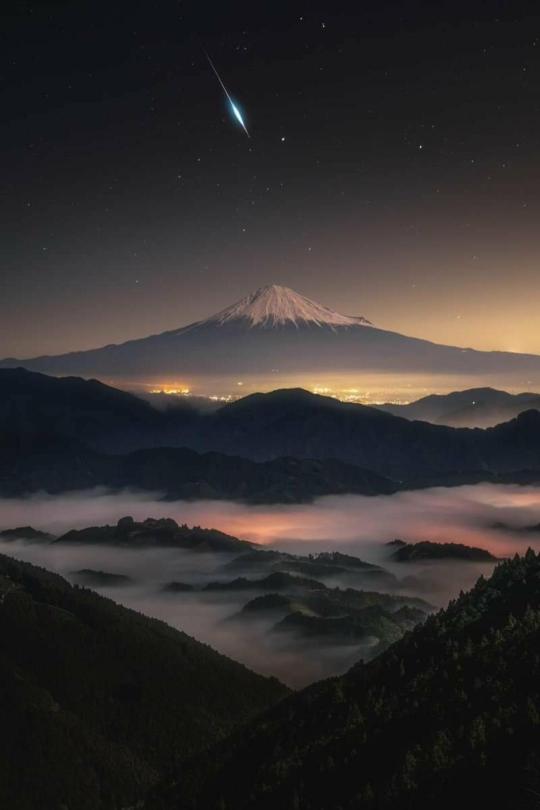#meteorite
Text










#lakes#lakeposting#poll#geology#geomorphology#nature#lake#naturecore#beautiful#limnology#science#ecology#aquatic ecology#water#meteor#meteorite#volcanic#glacier#glacial#tectonic#earth#environment#environmental science
2K notes
·
View notes
Text
I just snapped a meteor tonight during a long exposure... (Long enough that you can see the stars moving as the Earth turns.) Lower left.
8K notes
·
View notes
Text

Perish in Frost's adaptation of the Meteleaf scenes got me
#arknights#frostleaf#meteorite#dlarts#it's fine both of them have two hands#redleaf and firerite are still good#meteorite can't take any more senseless loss#and frostleaf throwing herself wholeheartedly because that's all she knows
512 notes
·
View notes
Text


Pallasite Meteorite
Imilac, Atacama Desert
Chile — 1822 Photo by u/misterbudz
#pallasite#meteorite#space#mineral#minerals#photography#art#gems#crystal#crystals#aesthetic#nature#landscape#portrait#contemporary art#landscape photography#curators on tumblr#painting#abstract
440 notes
·
View notes
Text



Fukang Meteorite found in China (2000) made up of large Oviline crystals and a nickel iron matrix which dates back to 4.5 billion years ago
756 notes
·
View notes
Text
Washington University has an incredible website about identifying meteorites run by Randy Korotev. It’s educational about what meteorites are and where they’re found (did you know that more meteorites have been found on Antarctica than on all other continents combined? did you know that 90% of meteorites are less than 14 cm / 5.5 inches long?) but its best feature is how fed it up it is with people who ask stupid questions and get combative (like, 243 emails combative) when told that actually, meteorites are quite rare. How fed up, you ask?

That fed up.
Some other highlights include:




And last but not least:

790 notes
·
View notes
Text

"A meteor shines brightly as it falls." Dream of stars. 1940.
Internet Archive
280 notes
·
View notes
Text

defender of the harvest
#Meteorite#snake#snakes#reptile#reptiles#reptiblr#corn snake#corn snakes#corn snake morphs#classic tessera corn snake
230 notes
·
View notes
Text

Meteorite above Mount Fuji, Japan. - H. Manabe
#go for queue deploy#mount fuji#japan#mountain#fuji#shooting stars#meteor#meteorite#night photography#space photography#stars#fog#nature#snow#night#night sky#astronomy#space#space and astronomy
630 notes
·
View notes
Text
Have you ever heard a meteor? Usually, meteors are too far away to make any audible sound. However, a meteor will briefly create an ionization trail that can reflect a distant radio signal. If the geometry is right, you may momentarily hear -- through your radio -- a distant radio station even over static. In the featured video, the sounds of distant radio transmitters were caught reflecting from large meteor trails by a sensitive radio receiver -- at the same time the bright streaks were captured by an all-sky video camera. In the video, the bright paths taken by four fireballs across the sky near Lamy, New Mexico, USA, are shown first. Next, after each static frame, a real-time video captures each meteor streaking across the sky, now paired with the sound recorded from its radio reflection. Projecting a meteor trail down to the Earth may lead to finding its impact site (if any), while projecting its trail back into the sky may lead to identifying its parent comet or asteroid.
#asteroid observations#asteroid astrology#meteorite#meteorology#astronomy photography#astronews#astrography#astronomers#astronomy#astrophotography#space science#planetary nebula#planetary science#science#nasa#universe#nasa photos#astrophysics#outer space#nasawebb#hubble space telescope#astro notes#astro community#astro observations#astroblr#astro boy#astrology observations#space station#nebula#space photography
127 notes
·
View notes
Photo

Meteorite
"And if I'm lying," he began . . .
Artist: Scott Murphy
TCG Player Link
Scryfall Link
EDHREC Link
101 notes
·
View notes
Text

Fireball! - February 26th, 1996.
"On rare but spectacular occasions, fireballs, meteors brighter than the brightest stars, flash through the heavens - sometimes making audible sounds and occasionally surviving to strike the Earth's surface. The path of one such fireball, recorded in January of 1995, skies over Hannover Germany, is shown above, the brilliant meteor easily outshining the stars of the constellation Orion (visible at the far right). In fact, for this brief moment, Sirius, the brightest star in the night sky, is overwhelmed as the image of the fireball grazes it. This dramatic event was recorded by a video camera observation technique known as MOVIE. Interplanetary space is littered with meteoroids, "rocks" tens of yards in diameter and less. Striking the Earth's atmosphere at high relative speeds, they leave visible trails known as meteors or, more poetically, "shooting stars". The trails are created when the intense heat caused by friction vaporises them. Fireballs can be caused by meteroids weighing small fractions of an ounce which do not survive to reach the ground. Remnants of larger ones, which do reach the ground after running this fiery gauntlet, are called meteorites. Though fireballs are rare, meteors are visible on any clear night of the year. Even outside the predicted regular meteor shower events, patient observers in dark sky areas can see several an hour - by just looking up!"
#nasa#space#cosmos#universe#astronomy#astrophysics#astrophotography#meteoroid#meteorite#shooting stars#orion
65 notes
·
View notes
Text
The Great Sand Sea Desert stretches over an area of 72,000km² linking Egypt and Libya. If you find yourself in a particular part of the desert in south-east Libya and south-western parts of Egypt, you'll spot pieces of yellow glass scattered across the sandy landscape.
It was first described in a scientific paper in 1933 and is known as Libyan desert glass. Mineral collectors value it for its beauty, its relative rarity – and its mystery. A pendant found in Egyptian pharaoh Tutankhamun's tomb contains a piece of the glass.
Natural glasses are found elsewhere in the world; examples include moldavites from the Ries crater in Europe and tektites from the Ivory Coast. But none are as rich in silica as Libyan desert glass, nor are they found in such large lumps and quantities.
The origin of the glass has been the subject of debate among scientists for almost a century. Some suggested it might be from volcanoes on the moon. Others propose it's the product of lightning strikes ("fulgurites" – glass that forms from fusion of sand and soil where they are hit by lightning).
Continue Reading.
101 notes
·
View notes
Text


Sericho Meteorite Slab | fasanarock on Instagram
#meteorite#pallasite#sericho meteorite#olivine#crystals#gems#stim#stims#stimmy#sensory#geology stims#trypophobia
133 notes
·
View notes
Photo


Tutankhamun's meteoric iron dagger,
Also known as Tutankhamun's iron dagger and King Tut's dagger, is an iron-bladed dagger from the tomb of the ancient Egyptian Pharaoh Tutankhamun (reigned c. 1334–1325 BC).
As the blade Composition and homogeneity closely correlate with meteorite composition and homogeneity, the material for the blade is determined to have originated by way of a meteoritic landing.
Since the 1960s, the high nickel content in the blade has been accepted as indicative of meteoric origin. A more recent study published in June 2016 derived from x-ray fluorescence spectrometer analysis show that the blade's composition is mostly iron (Fe) and 11% nickel (Ni) and 0.6% cobalt (Co). This means its composition is placed within the median of a group of 76 previously discovered iron meteorites.
The nickel content in the bulk metal of most iron meteorites ranges from 5% to 35%, whereas it never exceeds 4% in historical iron artifacts from terrestrial ores produced before the 19th century.
Also, the nickel to cobalt ratio of this blade is comparable to that of iron meteorite materials.[2]
At the time of King Tutankhamun's mummification in approximately 1323 BC (the Bronze Age), iron smelting and manufacture were rare. Iron objects were used for only artistic, ornamental, ritual, gift giving, and ceremonial purposes as well as for pigmentation. Hence, iron during this age was more valuable or precious than gold.
The dagger is currently displayed at the Egyptian Museum in Cairo
#art#design#Egypt#dagger#blade#meteorite#iron#tutankhamun#bronze age#alien#gold#king tut#style#history#nickel#cobalt#artifacts#ritual
314 notes
·
View notes
